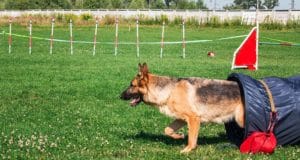It’s important to give a dog rules, boundaries, and limitations. In other words, our dogs need to know what they can do, where they can do it, and for how long. In this article, I’m going to focus on boundaries: teaching your dog where they are and are not allowed to go. Here are 5 Tips For Building Boundaries
Establishing boundaries can solve canine behavior problems like getting on the furniture, begging at the table, or bolting when a door is opened. In effect, when you create a boundary you’re building an invisible barrier and teaching your dog not to cross it.
So how do you create that barrier? Here are five tips.
- Claim your space
If you’ve observed dogs interacting, then you’ve probably noticed how they claim their own space. They do it physically, with body language and energy, and can get across the message “this is mine” without resorting to barking or showing their teeth.A dog claiming a food bowl or toy will stand above it, often leaning its head down protectively. A dog that wants to claim physical space from another dog will just walk right into her and push her away.To claim your space, you have to do the same thing, by controlling access to it with your body. If you don’t want your dog to walk through a doorway, stand in it. If you don’t want them on the couch, stand over it. - Take the lead
To help give your dog boundaries, you need to emphasize that you are the Pack leader, and a great way to do this is by creating the rule that you always go through a door first. You may need to start teaching your dog this with him on-leash, making him stop and wait at each threshold. After you go through, then you invite him to follow.Of course, the best way to be a Pack Leader is to give your dog exercise through the walk several times every single day, and teaching your dog to wait at doorways is a great way to help him learn how to follow you on the walk.
- Teach your dog to wait

- Correct at the right time
As with all other dog behaviors, the key to creating the boundary is proper timing in correcting your dog when he crosses it. If you’re trying to teach your dog to stay off of the sofa, it doesn’t do any good to come in and correct him while he’s on it.He won’t connect the correction to being on the sofa. Instead, he’ll connect it to whatever state of mind he’s in at the moment. If you correct him when he’s calm, you’ll just create a nervous or excited dog.The time to “Tsch!” or give whatever signal you use is right as the dog is about to commit the improper behavior. In the case of the sofa, it’s the instant he starts to jump on it. This will connect the correction to the action and firmly establish in your dog’s mind what he’s doing wrong. - Be consistent
Once you determine where your dog is and isn’t allowed, you need to be consistent in two things: one is maintaining the boundary. The other is being consistent in exceptions. If you decide that your dog can get on the sofa this time, it clearly has to be at your invitation — this is similar to teaching the dog to wait, in that it reminds her that you decide when to invite her into the territory but she is not allowed to invade it.Also, every human in the household has to enforce the same boundaries. If anyone doesn’t do this, it will just confuse the dog. Or, worse, it will make the dog think that the person who isn’t enforcing the boundaries is subservient to her.
Dogs look to their Pack Leaders for protection and direction. Giving them boundaries is a great way to provide the latter by letting them know where they can and cannot go.
Watch Cesar Millan explain how he reinforces boundaries with his own pack at home:
What boundaries do you enforce with your dog? Let us know in the comments!











